Computex 2014: The ASUS Booth Tour
by Ian Cutress on June 11, 2014 11:45 AM ESTGaming Motherboards
At the release of the Maximus VII series of ROG motherboards, we had the Gene, the Hero and the new member of the group, the Ranger. Oddly absent were the three more important members of that group – the Formula, the Impact and the Extreme. At Computex this year, at the ROG press conference, the Impact and the Formula were announced, but no Extreme. Actually one of my sources suggested that there will not be a Maximus VII Extreme for this generation, with effort being directed more towards the more extreme platforms expected later this year instead.
The Impact was one of the stars of the Z87 chipset, featuring a mini-ITX motherboard that proved to be a good extreme overclocker for memory but also featured in many small form factor gaming builds. This upgrade was exhibited in the Maximini, a case modification by reapervon:
Inside this small case is a GTX 760 DirectCU Mini, as well as a closed-loop liquid cooler for the CPU and low noise-fans. As I have mentioned over the years, some industries like to have technological showcases to prove what can be done, or to test what the public likes, and the motherboard industry is starting to jump on board. Sometimes these shows have custom mods that look great, this being one example.
The main feature point for the new Impact motherboard is the mPCIe Combo IV, featuring M.2 x4 support from the CPU, meaning PCIe 3.0 lanes. This is despite the lack of PCIe 3.0 M.2 drives out in the market right now – ASUS is expecting them within the next couple of iterations of M.2 however.
The Impact has an upgraded SupremeFX solution, which like in the last generation uses a daughter board to provide PCB separation and a focused audio design. The power connectors are both on the right hand side of the motherboard which should make cabling easier, and I really want to see this right angled power delivery migrate to other bigger form factors in order to provide space for other features.
One motherboard I was not expecting to see in the ROG section of the ASUS booth was the H97-Pro Gamer.
At this moment, this is not a full member of the ROG motherboard section, but it takes obvious cues from the ROG branding. I am unsure at this point of time if this motherboard is derived from the ROG team inside ASUS or the channel motherboard team, or if ASUS was just showing this motherboard to gain interest. Other motherboard manufacturers have moved some of their gaming range models to the H or B series chipsets with varied success, but I would be surprised if ASUS was trying to undercut their own Maximus VII Hero and Ranger models. H97 means no CPU overclocking of course, so I guess in an effort to provide cheaper options in markets where the high-end models are not applicable then going with a non-overclocking version might work. From the image above we can see SupremeFX integrated on the motherboard, as well as SATA Express and M.2. There are no TPU or EPU headers, and a big PCIe to PCI switch is also present.


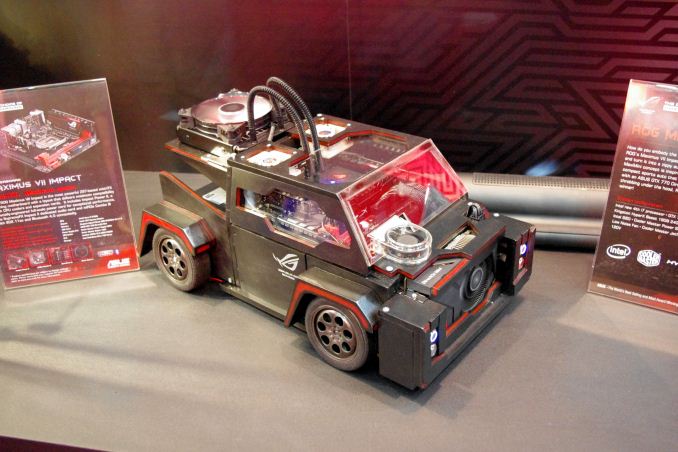
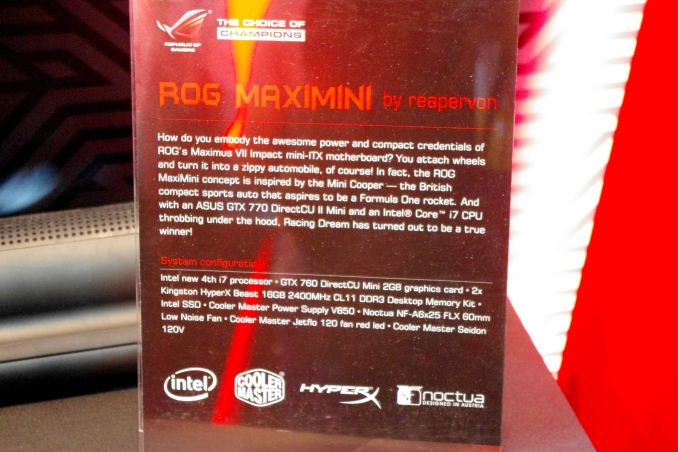
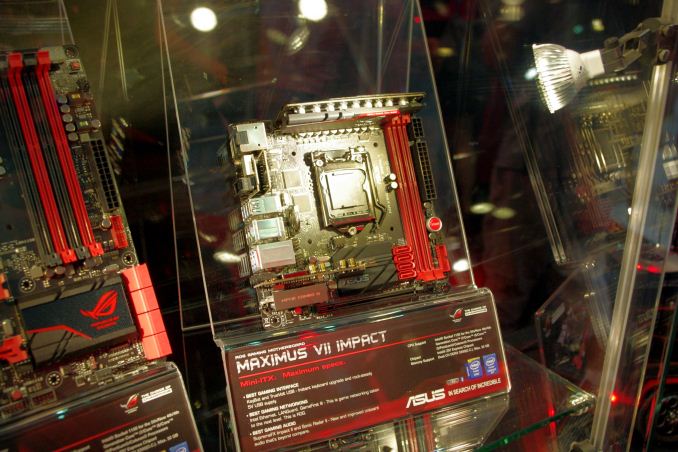
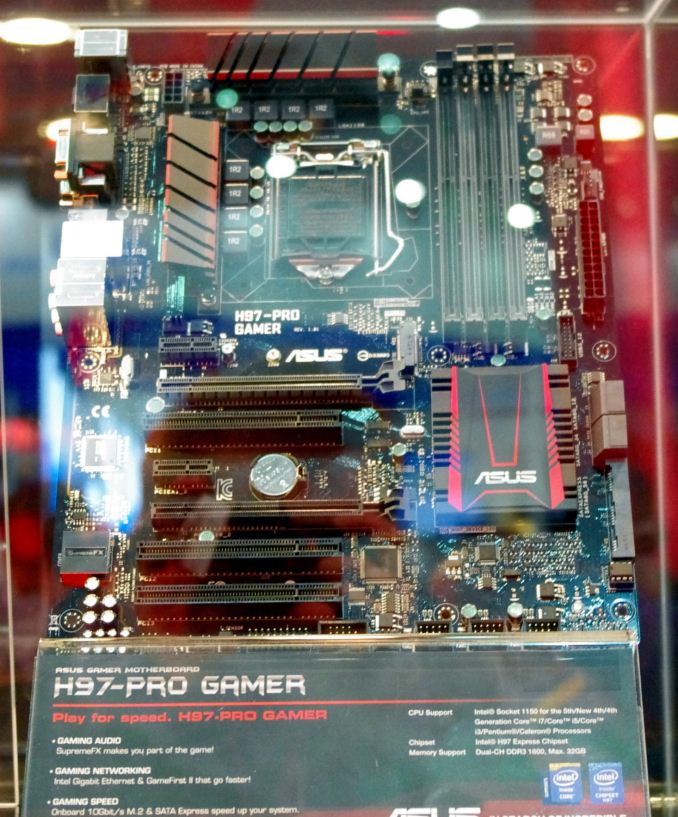
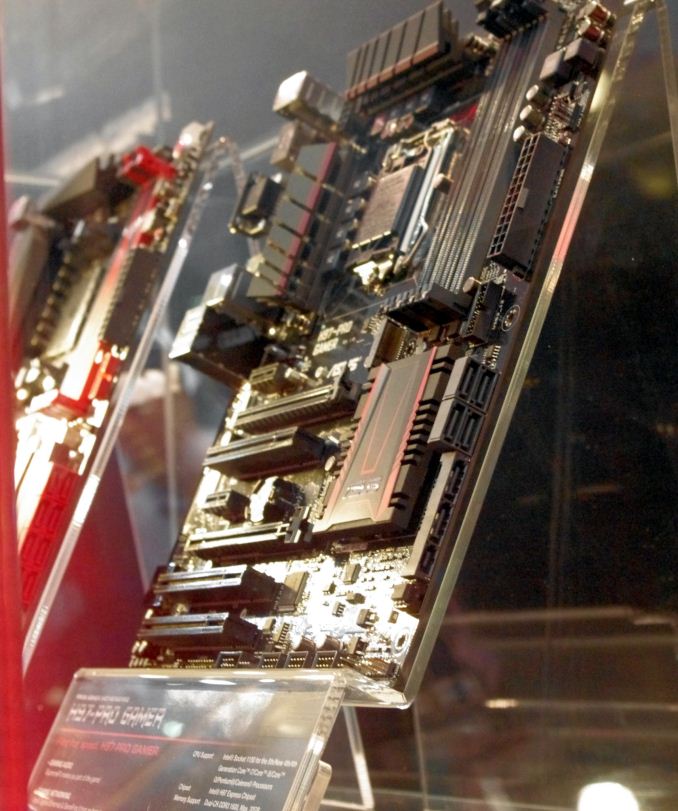








23 Comments
View All Comments
457R4LDR34DKN07 - Wednesday, June 11, 2014 - link
Are you sure the MPCIE combo IV is PCIE 3.0? JJ from ASUS told me it was PCIE 2.0.Ian Cutress - Wednesday, June 11, 2014 - link
I'm double checking for you. I was under the impression that it was only PCIe 2.0 by virtue of a lack of PCIe 3.0 drives but still PCIe 3.0 capable due to CPU lanes rather than PCH lanes. I'm sure I asked this question during my tour; I either remembered what I hoped, or what I heard, given the whirlwind of meetings that week. I'll update when I get an answer back.Ian Cutress - Wednesday, June 11, 2014 - link
I got a response: PCIe version not yet confirmed. Device is due out Q3, and they have time to choose either way. If you have a preference, note it here: I'm sure ASUS will be looking.PCIe 3.0 x4 will reduce the main GPU slot to PCIe 3.0 x8, but in my testing at 1080p gaming, frame rates drop less than 1%.
PCIe 2.0 x4 will give a full 16 lanes to the GPU, but might restrict some of the lane allocations for extra functionality. This effect is lessened by using a mITX board because there is less space for the extra functionality so the designers are restricted in what they can do.
457R4LDR34DKN07 - Wednesday, June 11, 2014 - link
I don't have a preference as I have a z77 and not compelled to upgrade until broadwell or beyond. If I was ASUS I would stick to PCIE 2.0 because: A) No current M.2 drives with gen3 B) PCIE 16X 3.0 might be more important in future video cards and is a more likely upgrade for a gaming motherboard.k4z3t5ub4k1 - Wednesday, June 11, 2014 - link
Awesome, thanks for taking the time to ask. IMO, on the Mini-ITX boards, I am hoping that the combo card is 4x PCIe 3.0 from the CPU. Since the Mobo only has one PCIe slot for graphics, thus SLI or Crossfire is not even an option, PCIe 8x is more than enough so satisfy the requirement of even a top end GPU. I would rather lose the 1% FPS going from 16x to 8x and gain the added storage speed that can be brought with M.2 over 4x PCIe 3.0.Freakie - Wednesday, June 11, 2014 - link
I would vote for PCIe 3.0. Waiting for drives to catch up is better than waiting for drives to be the ones that start. The faster the rest of the ecosystem is ready for a new technology, the faster we get the new technology. It would be nice if they could implement a BIOS feature to switch it from 2.0 to 3.0 (not sure if that is even possible) so that way we have the flexibility to upgrade in the future, or customize our current setup by deciding if we want to give the mPCIe device 3.0 bandwidth and sacrifice slight GPU performance, or give the device 2.0 bandwidth and keep the performance.In the end, I think SSD's need more attention than GPU's right now.
dgingeri - Wednesday, June 11, 2014 - link
I saw my MB up there in the Server section. The Z97-WS is a really nice board, but I have already had trouble with it. The DIMM slots 3 and 4 died on me after 10 days.I understand that issues like this do come up once in a while. (I'm the admin of a server software test lab. As reliable as server hardware is, I still have about a quarter of my time taken up replacing defective parts.) Still, Asus's support system is a bit lacking when things do go bad. I started this ticket last Thursday, and they still haven't shipped my replacement board. The hoops I had to jump through took me until yesterday to get done, and they say they'll ship it within 48 hours. It looks like I probably won't have a replacement in time for the weekend. This has discouraged me from buying any of their server line for my employer. It just takes too long to get things swapped, specifically because their support system is flawed.
extide - Wednesday, June 11, 2014 - link
If both slots on a single channel no longer work you may want to try removing and re-inserting the CPU... Sometimes you can have issues like that.dgingeri - Wednesday, June 11, 2014 - link
yeah, tried that. no luck. There are a couple solder points on the back of the board at the DIMM slots that look suspect, though. That's why I went for the RMA.martixy - Wednesday, June 11, 2014 - link
I've been waiting for precisely this article.Light on the details, but in any case at least we have an update on upcoming release dates, be it from here or other coverage of Computex.